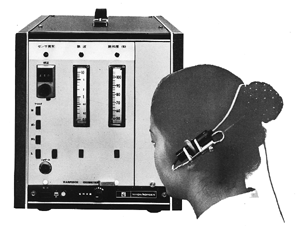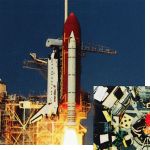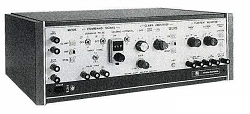
- 拡大
- OLV-5100 ear oximeter
In 1974, Nihon Kohden researcher Takuo Aoyagi developed the principle of pulse oximetry. The next year, Nihon Kohden introduced the world's first ear oximeter, OLV-5100, which used pulse oximetry to noninvasively measure saturated blood oxygen without the need to sample blood. All pulse oximeters today are based on Dr. Aoyagi's original principle of pulse oximetry.
The Oil Crisis of 1973 caused the most serious depression in Japan's history and Nihon Kohden was also confronted with the most serious business crisis in its own history. The company pulled together and as a result business revenues recovered in three years. After that, recession and severe business conditions for medical electronic equipment continued but Nihon Kohden entered its second golden era of rapid growth.

- 拡大
- Space shuttle photo
courtesy of NASA
In 1973, our ECG-2201 was described in the British Journal of Hospital Medicine as one of nine world famous portable electrocardiographs. Over 10,000 of these ECGs were sold and it became one of our longest selling products.
In 1979, Nihon Kohden established its first overseas subsidiary, Nihon Kohden America.
In the same year, Nihon Kohden was commissioned by NASDA (National Space Development Agency of Japan) to develop instruments for Japan's first contribution to experiments onboard the US space shuttle.

These were the world's first compact and lightweight EEGs, making them very easy to transport.

Originally designed only to count red and white blood cells, it was later modified to analyze hemoglobin, hematocrit values, and more elusive parameters. Over the years, a series of models with more extensive, sophisticated capabilities was developed and renamed "hematology analyzers."

This was Japan's first heart monitor with built-in memory.

This was Japan's first ink jet writing phonocardiograph.

This was Japan's first two channel amplifier.

This was Japan's first 1 channel PFB (position feedback) writing ECG. It also used dry cell batteries which had the world's longest battery life.

These were Japan's first EP/EMG needles that could be autoclaved.

This was the world's first microprocessor controlled EEG with CRT screen. Japan's first EEG scanner, the MCE-1100 (right), was introduced in the same year.
